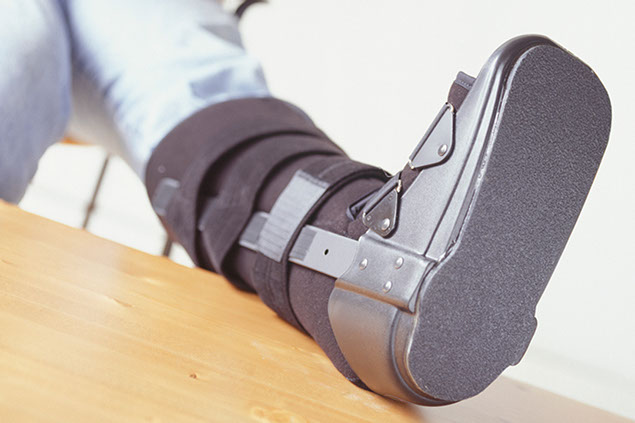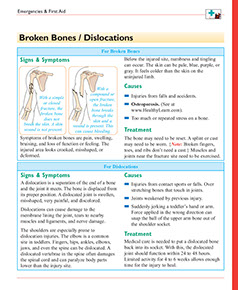CONDITIONS
SYMPTOM CHECKER
Male
Female
Child
Arm, Hand & Shoulder Concerns
Legs & Feet Concerns
Dental & Mouth Concerns
Ear & Nose
Eye Conditions
Head Conditions
Arm, Hand & Shoulder Concerns
Legs & Feet Concerns
Front
Back
Arm, Hand & Shoulder Concerns
Dental & Mouth Concerns
Ear & Nose
Eye Conditions
Head Conditions
Arm, Hand & Shoulder Concerns
Dental & Mouth Concerns
Ear & Nose
Eye Conditions
Head Conditions
Front
Back
Arm, Hand & Shoulder Concerns
Neck Links
Head & Neck Concerns
Arm, Hand & Shoulder Concerns
Neck Links
Head & Neck Concerns
Front
Back
Online Clinic
Wise Healthcare
Broken Bones / Dislocations
Print on Demand
RELATED ARTICLES
For Broken Bones
Signs & Symptoms
Symptoms of broken bones are pain, swelling, bruising, and loss of function or feeling. The injured area looks crooked, misshaped, or deformed.
Below the injured site, numbness and tingling can occur. The skin can be pale, blue, purple, or gray. It feels colder than the skin on the uninjured limb.
• Injuries from falls and accidents.
• Osteoporosis.
• Too much or repeated stress on a bone.
Treatment
For Dislocations
Resources
Signs & Symptoms
A dislocation is a separation of the end of a bone and the joint it meets. The bone is displaced from its proper position. A dislocated joint is swollen, misshaped, very painful, and discolored.
Dislocations can cause damage to the membrane lining the joint, tears to nearby muscles and ligaments, and nerve damage.
The shoulders are especially prone to dislocation injuries. The elbow is a common site in toddlers. Fingers, hips, ankles, elbows, jaws, and even the spine can be dislocated. A dislocated vertebrae in the spine often damages the spinal cord and can paralyze body parts lower than the injury site.
National Institute of Arthritis and Musculoskeletal and Skin Diseases (NIAMS)
Causes
• Injuries from contact sports or falls. Over stretching bones that touch in joints.
• Joints weakened by previous injury.
• Suddenly jerking a toddler’s hand or arm. Force applied in the wrong direction can snap the ball of the upper arm bone out of the shoulder socket.
Treatment
Medical care is needed to put a dislocated bone back into its socket. With this, the dislocated joint should function within 24 to 48 hours. Limited activity for 4 to 6 weeks allows enough time for the injury to heal.
Questions to Ask
Question 1
Do any of these problems occur?
• A severe injury to the head, neck, and/or back.
• Severe bleeding and a bone pushes through the skin.
• A very hard time breathing.
• An elderly person has fallen and can’t move or get up.
• Severe abdominal pain after trauma to the abdomen or back.
Get medical care without delay. If symptoms are life threatening go to the ER or call 9-1-1. Don’t call 9-1-1 or use the ER if symptoms do not threaten life. Ask your doctor ahead of time where you should go for a problem that needs prompt care, but not emergency care.
{Note: Give first aid for the problem as needed.}
Question 2
Are any of these problems present?
• Sweating. Dizziness. Thirst or an ashen skin color. Sudden shortness of breath follows an injury.
• Broken bone in the hip, pelvis, or thigh and the person can’t move. The skin under the fracture is cold and blue. Numbness or severe pain occurs below any other injured area.
• After a neck or back injury, a limb feels numb, weak or tingles. A bone breaks through the skin or bulges just under the skin.
Get medical care without delay. If symptoms are life threatening go to the ER or call 9-1-1. Don’t call 9-1-1 or use the ER if symptoms do not threaten life. Ask your doctor ahead of time where you should go for a problem that needs prompt care, but not emergency care.
{Note: Give first aid for the problem as needed.}
Question 3
Are any of these problems present?
• The person can’t move the limb, bear weight on it, or extend and flex it.
• Pain is severe. Pain, swelling, and discolored skin occur within 30 minutes of the injury.
• Pain and swelling get worse after 2 hours of using cold packs on the injured site and elevating it.
Get medical care without delay. If symptoms are life threatening go to the ER or call 9-1-1. Don’t call 9-1-1 or use the ER if symptoms do not threaten life. Ask your doctor ahead of time where you should go for a problem that needs prompt care, but not emergency care.
Question 4
Are any of these problems present?
• An injury to the face does not allow the jaw to open and close.
• A lot of bruising appears around the injury. Or, the area around an eye is swollen and discolored.
• It is hard to move the joint closest to the injury.
Get medical care without delay. If symptoms are life threatening go to the ER or call 9-1-1. Don’t call 9-1-1 or use the ER if symptoms do not threaten life. Ask your doctor ahead of time where you should go for a problem that needs prompt care, but not emergency care.
Question 5
Does the area discolor more in the first 24 hours after the injury? Or, do pain and swelling not improve or respond to Self-Care/First Aid?
You should be seen by your doctor for medical advice. Contact your doctor or health care provider to find out how soon you should be seen.
Use Self-Care / First Aid:
You can probably take care of the problem yourself if you answered NO to all the questions. Use the “Self-Care” measures that are listed. Call your doctor if you don’t feel better soon, though. You may have some other problem.
Self-Care / First Aid
For an Open Fracture
• Monitor for signs of shock.
• Control bleeding with direct pressure. Do not press on or move a bone that sticks out. Do not reset the bone.
• Immobilize the wound with a splint. Use a firm material, such as a folded newspaper or broom handle. Secure the splint above and below the injury or tie the injured part to an uninjured part. Use shoe laces, belts, etc. to hold the splint in place. Do not tie too tightly. Check the area below the splint to make sure that the skin is warm and pink in color. If not, loosen the ties.
For Fractures to Limbs
• To make an arm splint, put padding between the arm and the body. If an elbow is not involved, place the arm across the chest and wrap a cloth around the entire body. If the elbow is involved, place the arm straight or slightly bent against the body. Wrap the cloth around the body and arm.
• Make a sling with a triangular piece of cloth. Place the largest part under the arm and tie the ends at the neck.
• Make a splint for a leg or tie the injured leg to the other leg. Place padding in between the legs. Do not tie the splint too tightly. This could interfere with blood flow.
• Use cold packs on the injured site. Do not use ice next to the skin. This can cause frostbite.
• For pain, take an over-the-counter pain reliever as directed. Don’t use aspirin if you have bleeding.
For Dislocations
Dislocations need medical care. The longer they are out, the harder it is to get them back in.
• Immobilize the injured area above and below the injured joint.
• Don’t try to straighten a bone or joint that is misshaped. Don’t try to put a joint back in its socket.
• Apply cold packs to relieve pain and swelling.
• Follow your doctor’s instructions.
• Take an over-the-counter medicine for pain as directed.
This website is not meant to substitute for expert medical advice or treatment. Follow your doctor’s or health care provider’s advice if it differs from what is given in this guide.
The American Institute for Preventive Medicine (AIPM) is not responsible for the availability or content of external sites, nor does AIPM endorse them. Also, it is the responsibility of the user to examine the copyright and licensing restrictions of external pages and to secure all necessary permission.
The content on this website is proprietary. You may not modify, copy, reproduce, republish, upload, post, transmit, or distribute, in any manner, the material on the website without the written permission of AIPM.
2021 © American Institute for Preventive Medicine - All Rights Reserved. Disclaimer | www.HealthyLife.com
















































